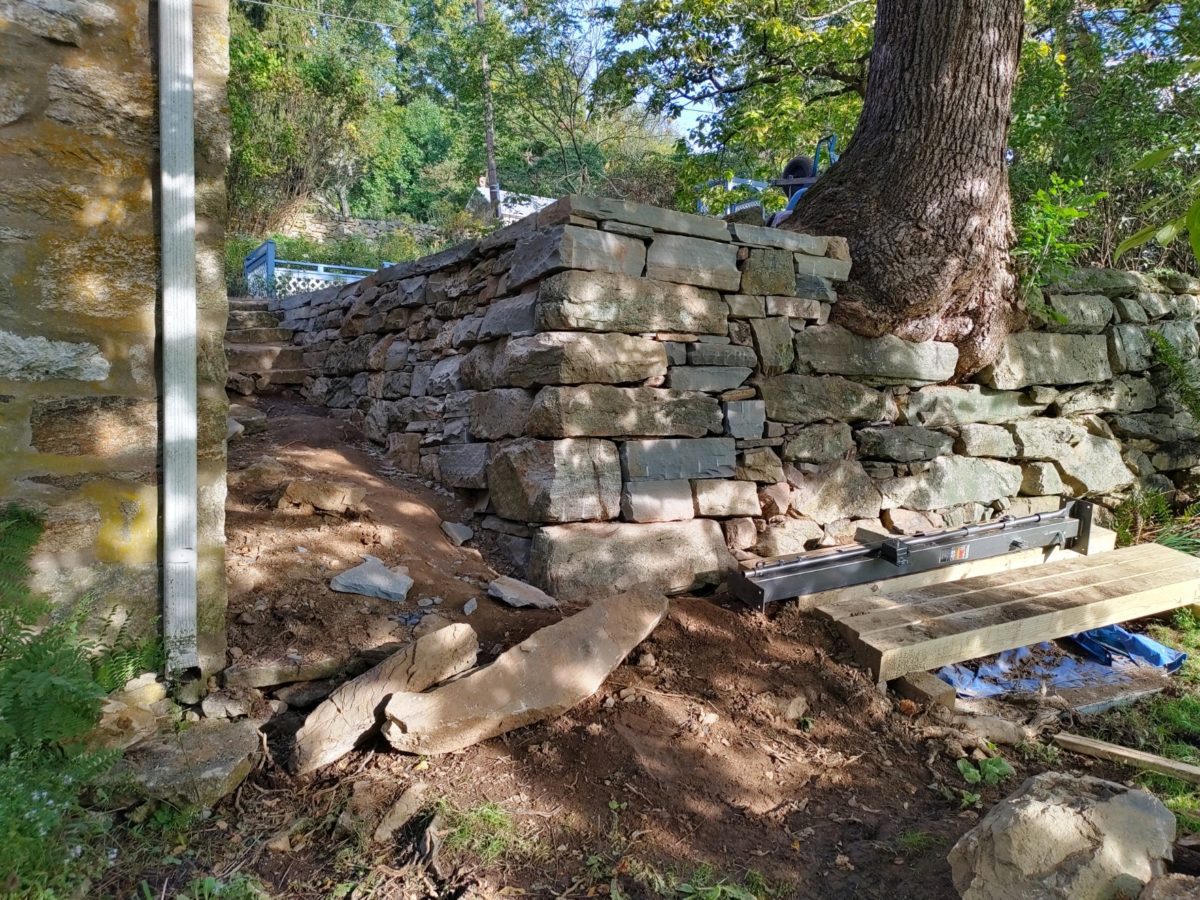 Devin Devine, dry stone walling contractor based out of Blakeslee PA
Devin Devine, dry stone walling contractor based out of Blakeslee PA
devin@devineescapes.com 610-301-4269
Rebuilding a large dry stone wall
This is not intended as a how-to article, merely a description of a recent project. If you’re looking for tips about how to move large stones without machinery, I have an article for you right here.
So the situation was a bit unique. Bit of a challenge. A 200 year old large dry stone wall needed to be rebuilt, as it was slowly falling apart. The wall had developed a bit of a bulge in it, and every year, it leaned a bit more forward. One particularly big stone, perhaps the biggest and heaviest stone in the wall, was sticking way out, and seemed almost as if you could just pull on it, and it would come out. Of course, that stone weighed around half a ton, so it would have taken some effort to remove it–but it was leaning out, precariously.
The challenge here was 3 fold:
- The wall was built from large boulders, too big for a man to move around without equipment.
- There was a spring house right in front of the wall, leaving a five foot wide path….no room to get equipment.
- Just downhill from the wall around the wall’s corner, where there was room to possibly get equipment, the ground was way too wet, perpetually. No heavy machinery was going to get involved in this project.
related content:
- dry stone glossary of terms
- how to build a dry stone wall
- building a dry stone sphere sculpture
- Building a natural stone birdbath
- how to level flagstone in stone dust
- dry stone wall contractor mentoring program
large wall, large boulders, tight space….no other contractor was willing to take on the job
How would they move the big stones around? Would one of their workers get hurt? Was there any way to make money off this job, or would it just cost them money and be a big reputation destroying mess and an insurance liability? On top of all of that– did their company even have any skilled dry stone wallers?
Sounds rough, but I was undaunted. We build dry stone walls all the time, this one is just bigger. It would be a challenge, sure, but challenges come and go and though the work may not be easy, it would be rewarding, it would be worth it. Careful work, cautious and sober minded work, sure, but heck–it’d also be fun. Modern skid steers and backhoes are cool too, but how did they build things like this back in the day? I bet they used *man-powered cranes!
*perhaps oxen were used.
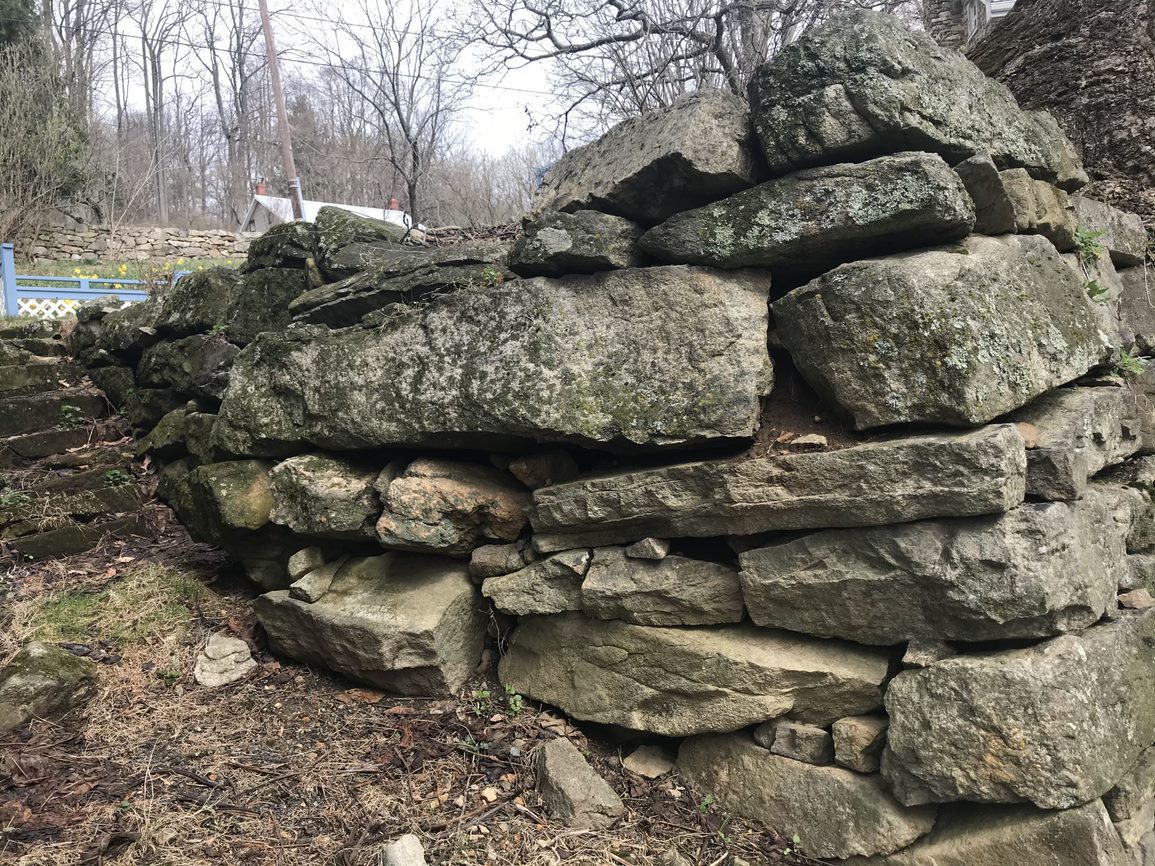
BEFORE shot: the wall was a bit of a dangerous situation, with huge boulders ready to collapse.
Moving boulders, without a skid steer. Further complications:
The wall had a large tree growing into it. In places, the wall and the truck and roots of the tree were as one body. A catalpa tree, huge and beautiful, the homeowner did not want the tree cut down as the expense would be significant, the loss of beauty to the property would be large and the wall and tree had stood together for possibly 200 years, with the wall only beginning to fall down for the past 5 years or so. So we had to re-build the wall without killing the tree!
Oh, and just beneath the tree’s trunk, there was a well cover. So the goal then was to take down the wall, without taking down the tree, and without allowing the wall or tree to collapse and destroy the well.
My solution was simple. On visiting the site in Barto, for a site consultation, I decided a gantry crane and chain hoist would make the work possible.
Disclaimer: don’t you kids try this at home!
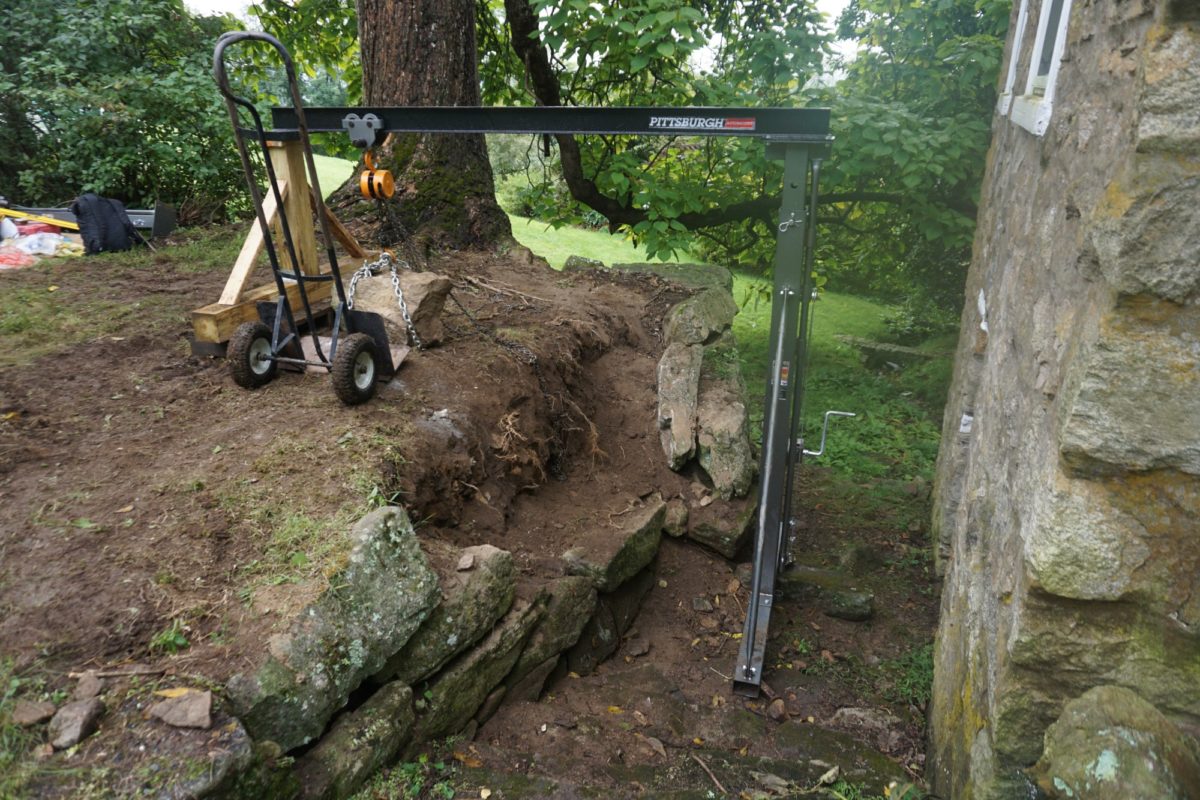
Here was are beginning to take apart the old wall, using the crane. Already you can see modifications begun upon the crane, the one leg being replaced with a shorter, home made leg.
The photo above shows the wall, pretty much as we found it, except for maybe 3 stones have been removed from the top of it.
What caused the wall to fail though?
Two things you can see, just from the photo.
- The tree, a large tree, is right there, right up on the retaining wall. Its roots seem like a pretty clear culprit. But what else do we see?
- The stones, large though they are, are all set out with the length spread across the wall–rather than with their length going into the wall. In waller-talk, we’d say “no through stones, all tracers!”
Having taken apart this wall, I can tell you that it was a single-faced wall, back-filled with rocks and soil. Of course, that’s not the way I want to see dry stone walls built–we want to see double faced walls, well-hearted, with plenty of through stones and no vertical seams.
Okay but the wall DID survive around 200 years or so….
We can attribute this longevity largely to the size of the stones used. Huge pieces of stone, with plenty of mass, plenty of volume, just too heavy to be easily moved. The earth behind the wall may heave and shift, but the gravity of them stones kept them in place. But the wall was failing in one specific location (in the photo you can see 3 stones tumbling out of the wall. They have not been moved–all that was done before the photo was taken was 3 stones removed). In that location was……a vertical seam, of course! When we removed those tumbling out stones, what did we find behind them? You guessed it–a great big root!
So okay, if double-faced and without any vertical seams……the wall may still have been shoved out of position, somewhat, by that root, but probably wouldn’t have been falling apart quite as badly as it was when I showed up.
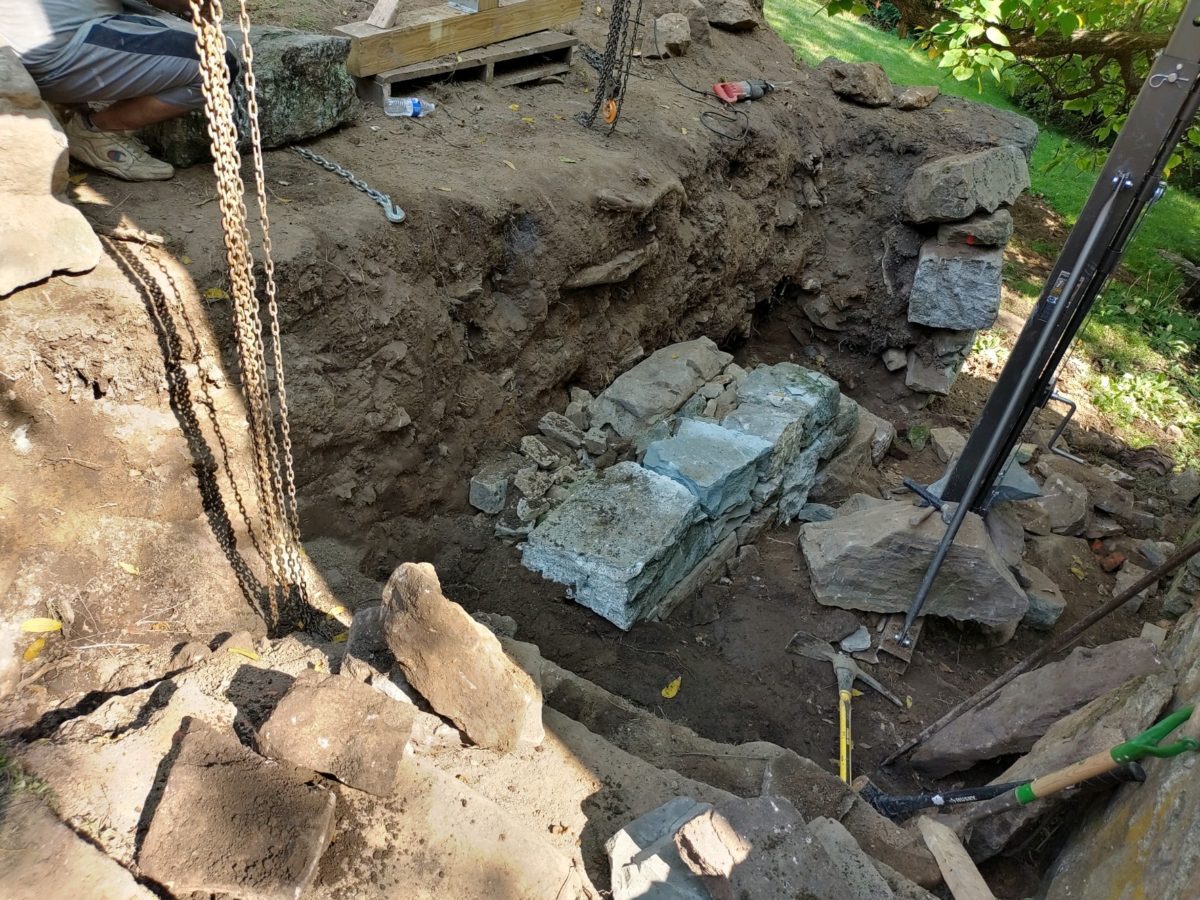
And so we took it all apart and began re-building it.
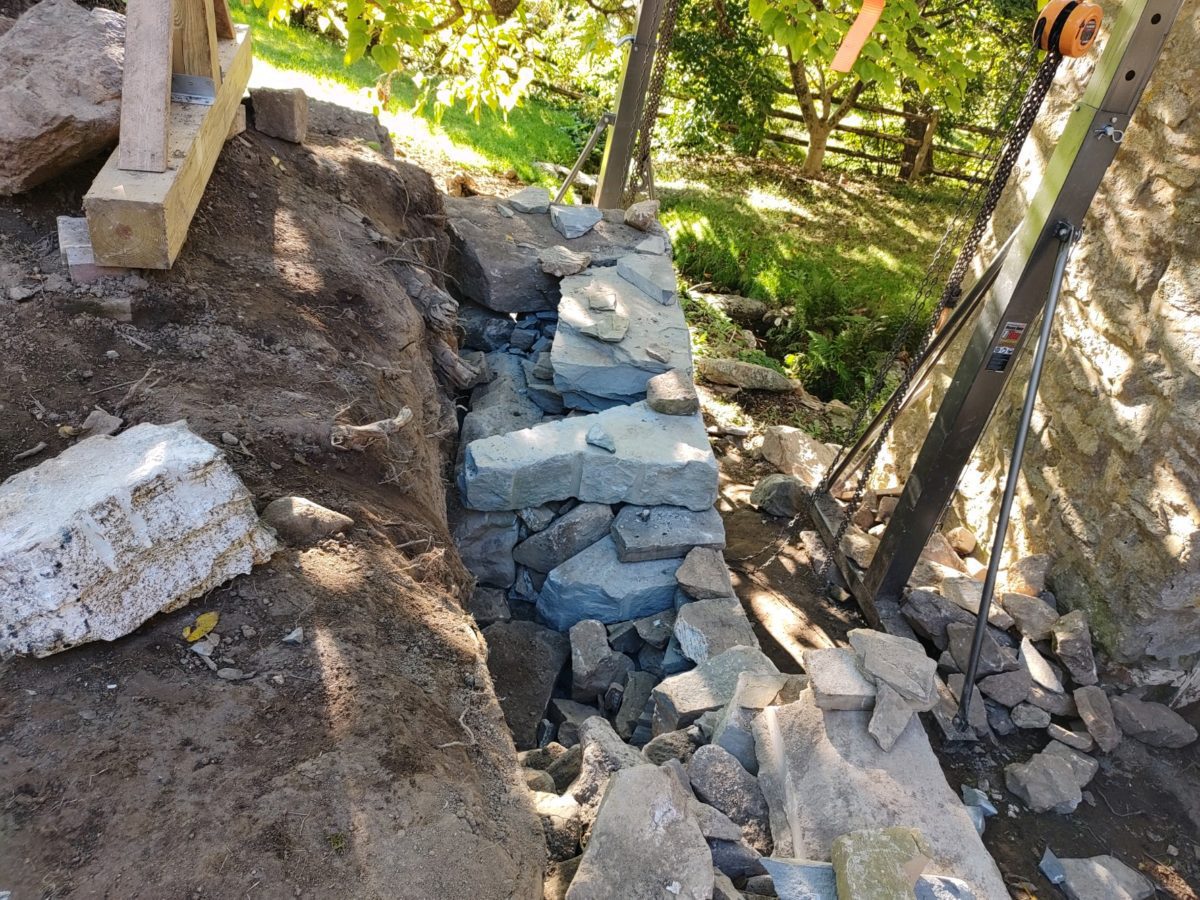
Double faced dry stone wall, with through stones.
Big wall requires…..BIG gantry crane!
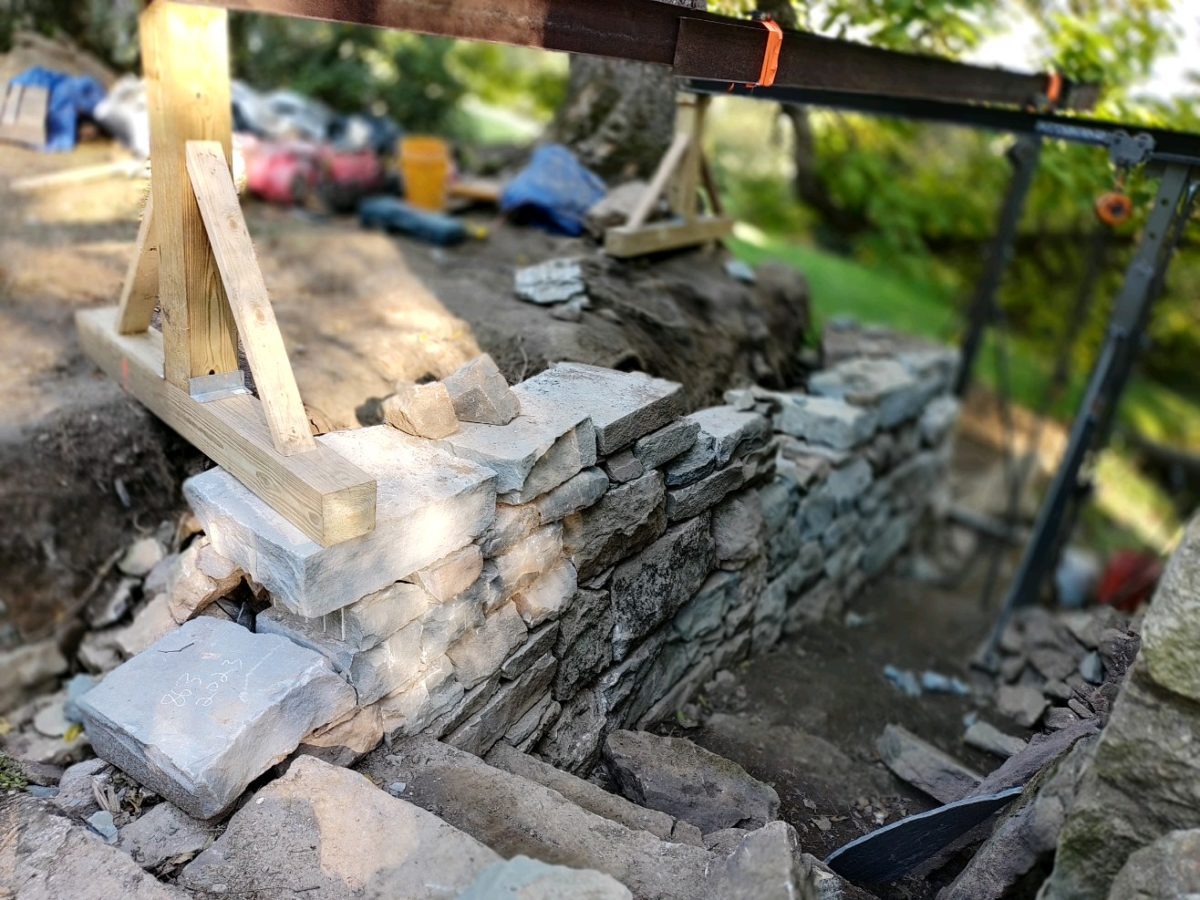
And we continued building…eventually realizing that a single crane going in one direction just wasn’t going to cut it. Some modifications were made, eventually resulting in a t-shaped crane, with tracks going in both directions.
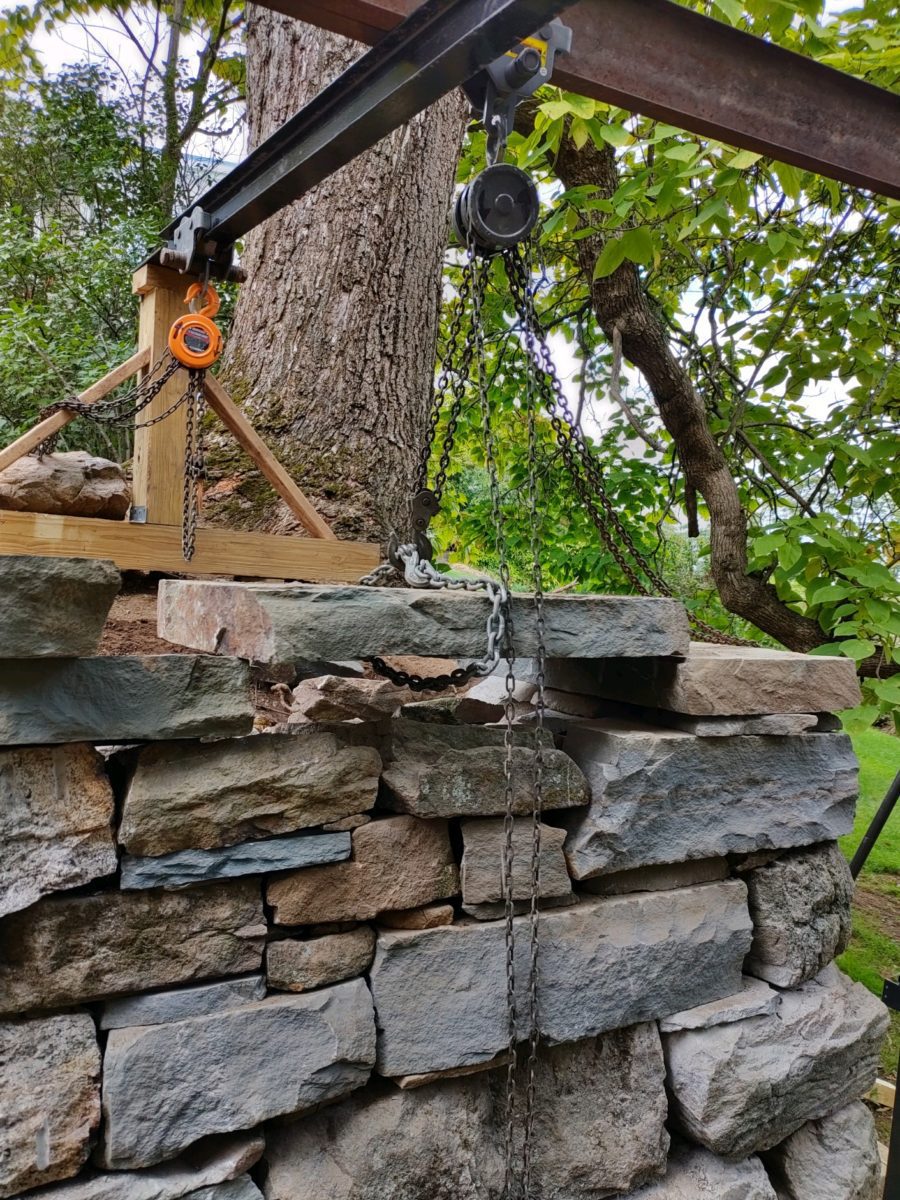
My coworker had the good sense to draw up and down arrows on the chain hoists–without the arrows, you’re always pulling on the chain for like 20 seconds before realizing you’re going the wrong way! Also note, the chain hoists are the SLOW way to go about this. An electric winch may have gone faster–which sounds good, right–getting the work done faster. Of course that’s good! But then, when you have a large 900+ pound boulder up above your head, perhaps you’d rather things move more slowly, yes? So I did the entire wall slower then, preferring not to drop any thousand pound boulders on my head.
Using the crane to build a dry stone wall
The original stones, which had previously been laid length-wise across the wall, were set into the wall. In most cases, the long end of the stone did not have a usable face. So we drilled and split those large boulder in half, using feather and wedge methods, as described here. The split face was then used, with the length set into the wall, and the drill holes were left visible, on the wall face.
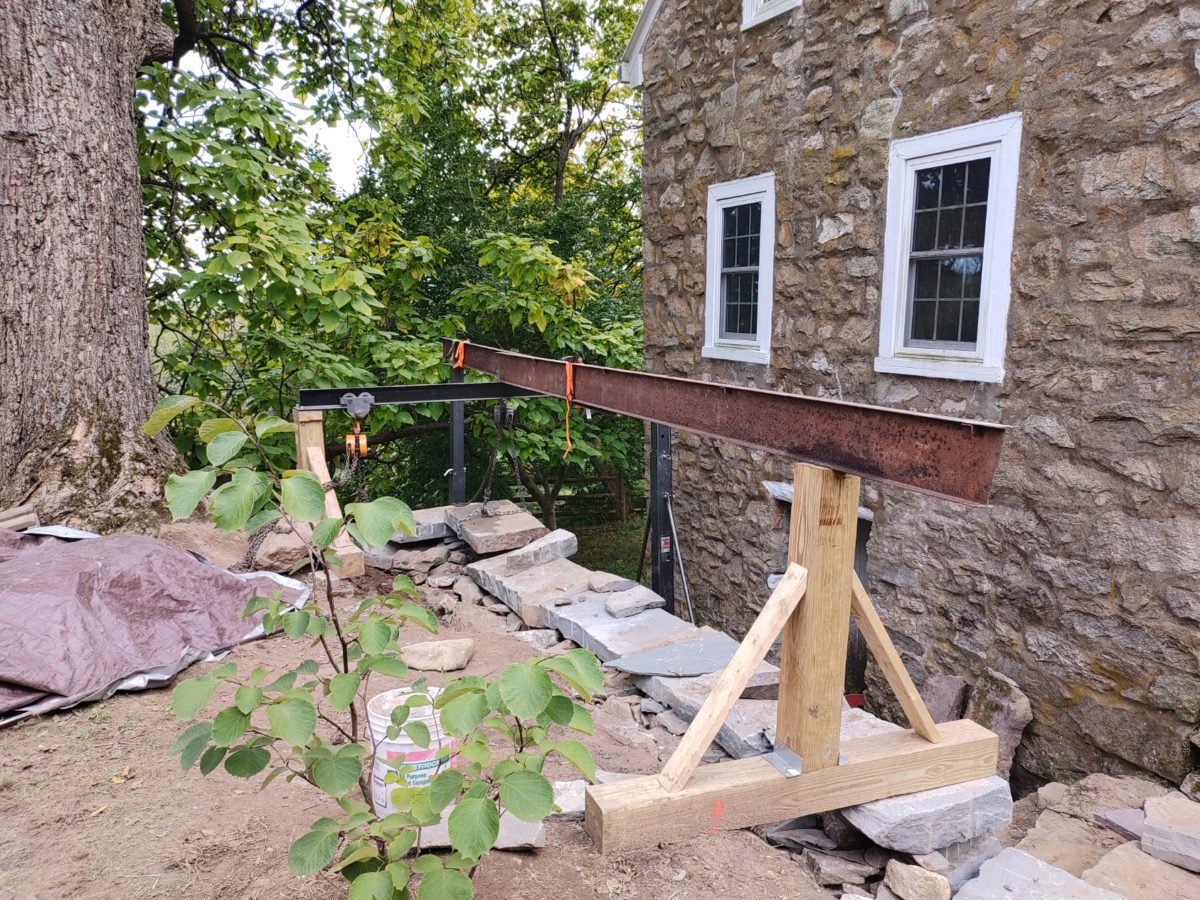
Another photo showing the crane. The crane had 3 separate tracks…..we only had 2 trolleys and 2 chains hoists though,so we had to remove and re-set one of the trolley/hoists, a couple times. In retrospect–I’d have done the t-shaped crane modification from day 1, and would have purchased a 3rd hoist and trolley. Yes, I considered that idea on day 1. Wasn’t sure if it’d be worth it. It would have! The t-shaped 3 track set up was sweet.
Here’s the tools I used to shape these stones:
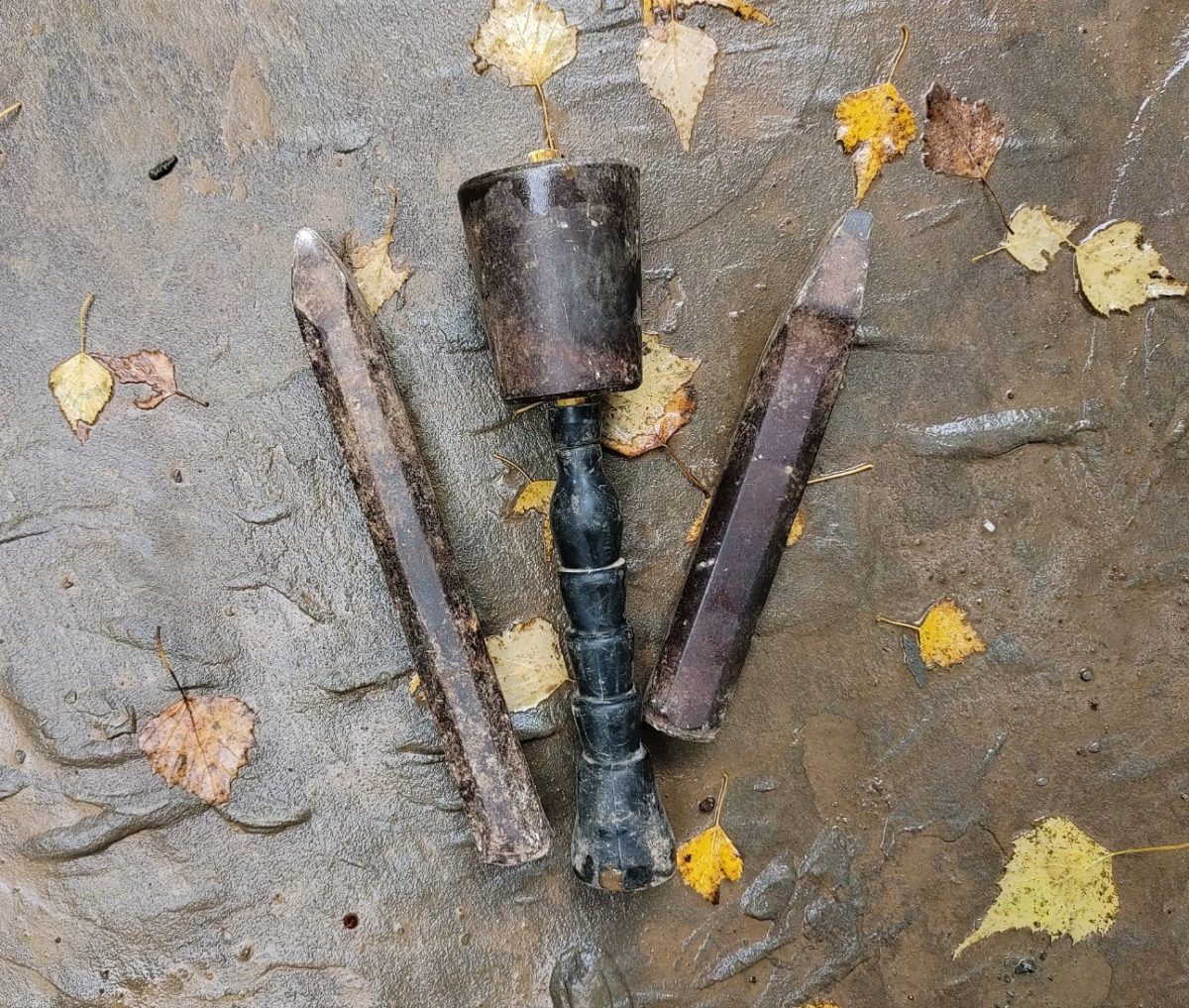
L to R: Point chisel (carbide tipped), Bell Hammer, and 2″ Hand Set (also carbide tipped). The 14″ saw was on site, but never used. The 5″ angle grinder was used on 1, maybe 2 stones. Hammer and chisel were used on many of the stones. The hammer, drill and feather and wedges were used to split or cut maybe a dozen of these stones, maybe six of the native gneiss/granite boulders and maybe another 6 or so of the large bluestone wall stones we brought in.
Large wall in tight space, completed:
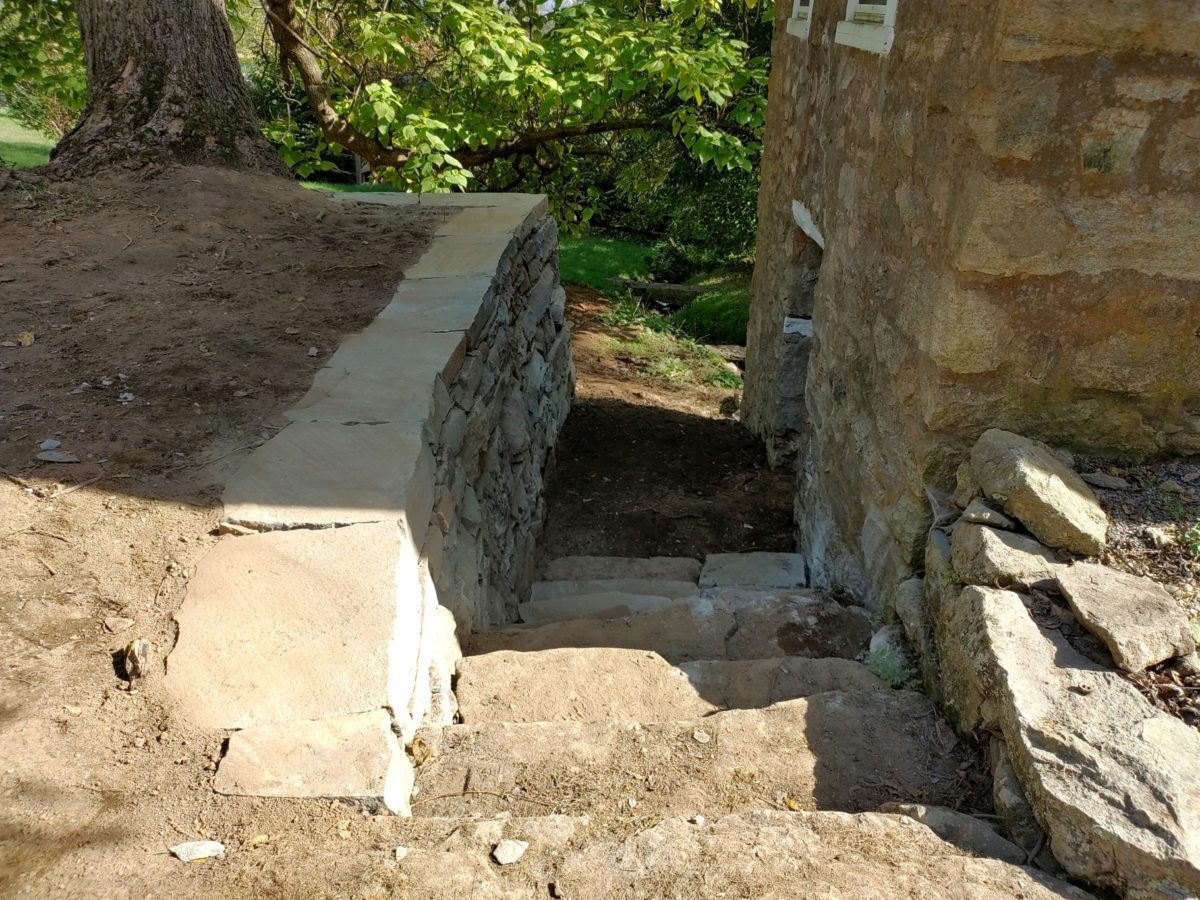
Happy customer, too–Read their review, HERE
We need to move eighty 1500 lbs redi-rock concrete blocks a distance of about 500-feet through a forest in a National Park. The project site in the park is about 55 feet lower than the edge of the National Park, where the blocks will be dropped off. The National Park doesn’t want us driving heavy equipment through the park to bring in these big, heavy blocks. We’ll need to bring in 80 of these big stones. Your gantry crane idea might be an option for us to bring these stones in through the park to the project site where we need them without using motorized heavy equipment. Thank you.
So you’re thinking to lift the blocks using the gantry crane, and then use steel pipes or something similar, as rollers?